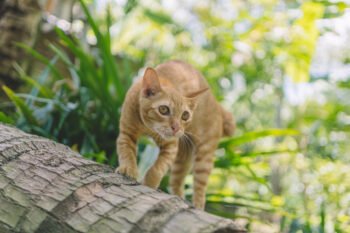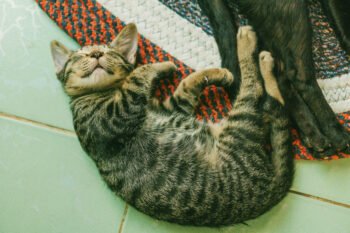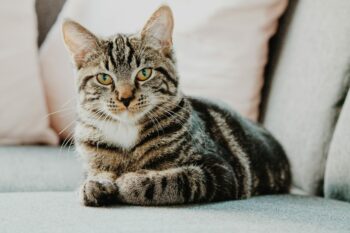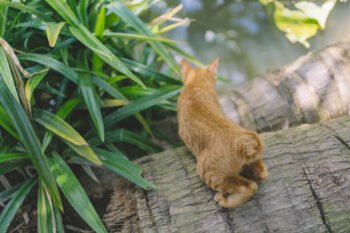Has your cat’s natural fur coat lost some of its former lustrous sleek shine? This visual signal could be a message to you that your furry friend is not receiving enough of the right nutrients in its diet. Protein, fat, vitamins and minerals are all essential for supporting the skin and coat health of your cat. To understand the role of these nutrients, you should first learn a few things about skin and hair.
Medical researchers believe the purpose of skin and hair is to block things from leaving or entering the body. Water and heat are two things that the skin and hair often help your feline to retain, while viruses and bacteria are sent packing.
Your cat’s hairy coat is composed almost entirely of protein. If your pet’s diet doesn’t contain sufficient amounts of certain proteins, the fur literally may fly, since it could fall out. The fur may also become dry, weak and brittle.
Skin, on the other hand, is made up of something called “squamous cells.” These are flat cells that are packed tightly together. The cells have tough membranes composed of proteins and fats. Without proper amounts of these nutrients, cell membranes can weaken, which could allow water to escape. At this point, bacteria and viruses may then enter your cat’s body more easily.
Essential Amino Acids and Fatty Acids
Amino acids are the building blocks of proteins. Both animal and plant-based ingredients may contain proteins, but those found in animal-derived foods usually contain all of the essential amino acids that your cat will need. Plant-based proteins, however, may contain only some essential amino acids. Your cat therefore needs animal-based proteins to achieve optimal health.
Fats can also be found in both animal and plant-based ingredients. They are incorporated into skin cells as fatty acids. There are two essential fatty acids for skin and coat health. Linoleic acid maintains skin and coat condition in your cat. Without enough linoleic acid, your pet may experience a dull, dry coat, hair loss, greasy skin, and even an increased susceptibility to skin inflammation. Your cat also requires something called arachidonic acid to maintain its skin and coat health.
Both linoleic and arachidonic acid are in the omega-6 fatty acid group. These essential fatty acids are found in animal tissues like chicken fat and in vegetable oils, such as those derived from corn and soybeans.
Most commercial cat foods contain more than adequate amounts of omega-6 fatty acids, but because your feline’s body can convert these fatty acids into compounds that promote skin inflammation, it is important to balance the omega 6’s in your cat’s diet with omega-3 fatty acids, which do not promote inflammation.
Omega-3 fatty acids are found in oils from fish and some plants, such as canola and flax. You have probably heard about the importance of these acids in human health as well. Scientific researchers have found what they believe is the perfect ratio of fatty acids in kitty diets. This is 5-10 omega-6 fatty acids for every 1 omega-3 fatty acid. That delicate balance seems to help cats to achieve a healthy coat and skin.
Vitamins and Minerals
Vitamins and minerals are equally important in the development and maintenance of your cat’s skin and fur coat. The best way that you can provide these nutrients is by providing your cat with a complete and balanced diet that contains appropriate amounts of essential vitamins and minerals. It is best to do this through your cat’s food rather than attempting to make corrections by use of dietary supplements.
Here is a handy guide that explains how certain vitamins and minerals may affect your cat’s health and appearance.
Changes in Coat Condition
While diet may be to blame for your feline’s flaky skin and dull coat, other factors are at work too. Aside from nutritional imbalances, common causes for undesired changes to the appearance of your feline’s skin and fur include seasonal influences and factors associated with aging.
In terms of the seasons, cold weather usually prompts internal changes that enable your cat to grow a thick coat to help it to lock in heat and to keep cold air out. When the weather warms up, your kitty sheds much of its thick, heavy coat.
As a kitten, your cat likely had soft fuzzy hair, but with age, your little fuzzball developed a coarser coat. Pregnant felines also may experience a change in coat condition or hair loss. And, as with humans, the hair on your cat as it reaches its senior years may thin out and become coarser. It could even turn white.
Skin and fur problems associated with aging may be mostly out of your hands, but your pet’s nutrition isn’t. Cats seem to pride themselves on their appearance, and that includes their sleek fur. Don’t let your cat down. Feed your feline a balanced diet with appropriate nutrients to help ensure that your cat will look and feel its very best.







